
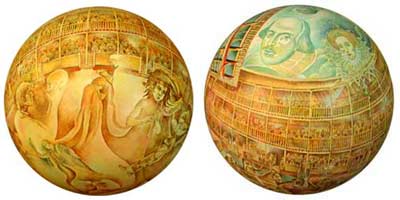 The Globe Theatre in London
The Globe Theatre in London
This is a 24-inch diameter spherical painting of Shakespeare’s Globe Theatre in London. Markie and I were there two years ago. It seemed the perfect subject for a Termesphere globe of the Globe. Later when I decided to create this piece I researched it in books, the Internet and the movie “Shakespeare’s in Love”. The cylindrical auditorium with the small compartments for seating helped with the idea that “all the world’s a stage.” Images of five plays are shown in this piece as well as images of Queen Elizabeth and Shakespeare.
In the Works
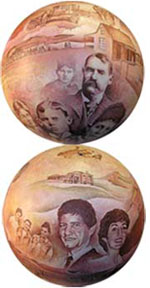
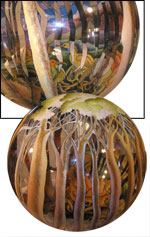 I am working on a 24″ sphere commission for Tom and Theresa Matthews. They live just over the state line in Beulah Wyoming. The sphere plays with images of the Matthews’ Ranch twenty miles south of Gillette Wyoming. Four generations with the name Tom Matthews have worked on this family ranch from 1881 into today. The T7 Ranch, as it is called, has been the foundation for many Matthews individuals. The Matthews family was responsible for the Matthews Opera House as well as the whole Matthews Block of buildings in Spearfish South Dakota. This sphere incorporates these people and their influence in this area.
I am working on a 24″ sphere commission for Tom and Theresa Matthews. They live just over the state line in Beulah Wyoming. The sphere plays with images of the Matthews’ Ranch twenty miles south of Gillette Wyoming. Four generations with the name Tom Matthews have worked on this family ranch from 1881 into today. The T7 Ranch, as it is called, has been the foundation for many Matthews individuals. The Matthews family was responsible for the Matthews Opera House as well as the whole Matthews Block of buildings in Spearfish South Dakota. This sphere incorporates these people and their influence in this area.
I am also working on a transparent sphere which may be called CREATURES ON THE FOREST. It will have a forest on the front side of the sphere. Through the open transparent spaces between the trees you will see creatures and a landscape on the backside of the sphere. This sphere seems to open another whole direction for the Termespheres. The image shown below is an in-process photo of the two sides of this painting. It is a challenge to paint two different images on the same place. Another transparent sphere painted ahead of this one is REFLECTIONS THROUGH THE MIRROR (which is also transparent).
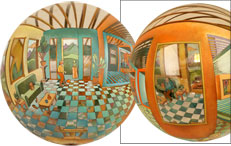
This room is filled with mirrors on the walls. When you look into the transparent mirrors you see what is on the back side of the sphere. The cool part of this piece is that the reflection is reading correctly, it is what would be behind you and also a backwards mirror image. It is an odd place to find a true refection–on the back side of the ball.
Publications
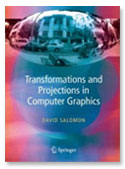 TRANSFORMATIONS AND PROJECTIONS IN COMPUTER GRAPHICS by David Salomon was published by Springer 2006. I am very pleased to have this book dedicated to me. My contribution to this book has to do with the use of many of my images. In the section on CYLINDRICAL PANORAMIC PROJECTION Solomon uses my continuous Four Point Grid and one of my drawings. He also used my grids from one through six point perspective and examples of my drawings with each. The drawing of St Peters as a dodecahedron is also used. My patent on the TOTAL PHOTO is included. I was pleased with this as many new approaches to capturing total 360-degree worlds are coming into being and it is nice to have them know I was there in 1980.
TRANSFORMATIONS AND PROJECTIONS IN COMPUTER GRAPHICS by David Salomon was published by Springer 2006. I am very pleased to have this book dedicated to me. My contribution to this book has to do with the use of many of my images. In the section on CYLINDRICAL PANORAMIC PROJECTION Solomon uses my continuous Four Point Grid and one of my drawings. He also used my grids from one through six point perspective and examples of my drawings with each. The drawing of St Peters as a dodecahedron is also used. My patent on the TOTAL PHOTO is included. I was pleased with this as many new approaches to capturing total 360-degree worlds are coming into being and it is nice to have them know I was there in 1980.
FOOD FOR THOUGHT AND THE SPHERE CALLED EMPTINESS are shown in full color.
Workshops
The South Dakota Lions Club hired me to do workshops with a group of International students in Volga South Dakota July 2-3 and 4th. We produced a large icosahedron that was left at the sight.
I was at Western Washington University in Bellingham July 11-14 this summer. I worked with 70 math teachers. They came from all over the state of Washington. I did the perspective workshop and the polyhedra workshop. It was exciting for me to see how the math mind related to these workshops. They did a wonderful job, by the way.
The end of September I flew out to Phillips Exeter Academy and spent three days. I had sent ahead a showing of Termespheres. I also did workshops with the math and art students. What a fun educational environment that was!
I spent a day doing workshops on perspective with the National Veterans Creative Arts Festival in Rapid City October 20th 2006. Along with the workshop I had eight Termespheres hanging around in the environment.
Virtual Termespheres
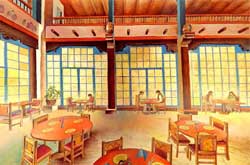 Ryan Packard has put together some wonderful Virtual Panoramic views of my Termespheres. He puts you inside six spheres that you can turn with your mouse to see any part of them. You can find them on the homepage of my site www.termespheres.com You must look at them! They are way cool. These virtual programs are of FOOD FOR THOUGHT, ST. MARKS SQUARE, LOOKING FOR THE ORDER, THE PANTHEON, LORETTO CHAPEL IN THE ROUND and OLD BALL GAME
Ryan Packard has put together some wonderful Virtual Panoramic views of my Termespheres. He puts you inside six spheres that you can turn with your mouse to see any part of them. You can find them on the homepage of my site www.termespheres.com You must look at them! They are way cool. These virtual programs are of FOOD FOR THOUGHT, ST. MARKS SQUARE, LOOKING FOR THE ORDER, THE PANTHEON, LORETTO CHAPEL IN THE ROUND and OLD BALL GAME
Quicktime credit to Ryan Packard
Awards
I received a couple of honors this last month.
RUSHMORE HONORS by the Rapid City Area Chamber of Commerce Sept 14, 2006.
SPEARFISH HIGH SCHOOL FINE ARTS HALL OF FAME which will be given December 14, 2006.
Six Point Perspective
SIX POINT PERSPECTIVE ISN’T JUST FOR THE FUN OF IT,
IT’S IN THE REAL WORLD ALSO
By Dick Termes 10-06-06
This will become a major paper but I will try to condense this idea for the newsletter.
My thesis is that spherical paintings are closer to reality than flat paintings.
 Any painter should be aware that if you are true to the reality of what we see, all paintings, including flat ones, are a piece of the whole visual sphere around you. If you don’t think the visual world is a sphere around you, take another look. The image in front of you is attached to more and more image until it comes right back to the original image, any direction you might want to go. This is a sphere. Six point perspective is the order this world around you can be organized to. Six point perspective especially works well if the environment around you is a cubical environment.
Any painter should be aware that if you are true to the reality of what we see, all paintings, including flat ones, are a piece of the whole visual sphere around you. If you don’t think the visual world is a sphere around you, take another look. The image in front of you is attached to more and more image until it comes right back to the original image, any direction you might want to go. This is a sphere. Six point perspective is the order this world around you can be organized to. Six point perspective especially works well if the environment around you is a cubical environment.
 To help explain the statement above, think about this: Imagine being inside a transparent ball that you have put six equal distant dots on. With the transparent ball on your head, move inside a cubical building. Look through the transparent ball at the building’s three sets of parallel lines. They run north/south, east/west and up and down. The rule in traditional perspective is all parallel lines go to the same vanishing point. In my system of six point perspective on the sphere, all parallel lines go to two vanishing points, north/south, east/west and up/down. These points will be opposite poles on the ball.
To help explain the statement above, think about this: Imagine being inside a transparent ball that you have put six equal distant dots on. With the transparent ball on your head, move inside a cubical building. Look through the transparent ball at the building’s three sets of parallel lines. They run north/south, east/west and up and down. The rule in traditional perspective is all parallel lines go to the same vanishing point. In my system of six point perspective on the sphere, all parallel lines go to two vanishing points, north/south, east/west and up/down. These points will be opposite poles on the ball.
 As you look through your transparent ball, make sure one of the dots on the transparent ball is directly above your head. Keep your eyes in the center of the ball when observing all of this. Now, look at the outside building and look where one of the vanishing points would be located. Remember, all parallel lines go to the same vanishing point. When you have located one of the vanishing point of your building, line up this vanishing point with a dot on the ball. After you have overlapped this vanishing point with the dot on the ball, keep the ball stable. Now rotate your eyes within the ball and notice all the other lines of the outside building will project to the other dots on the ball. If the first set of lines you worked with run to the north direction then they will also run across the ball to the south direction. Turning your eyes now within this stable ball notice the next dot to the east will also line up with the dot on the ball. Those lines that aim at the east vanishing point (and dot also) will swing across the ball in greater circles to the west vanishing point which is also another dot on the ball. You don’t have to be in the center of the cubical room for this to happen, it will happen no matter where you are located within the cubical building.
As you look through your transparent ball, make sure one of the dots on the transparent ball is directly above your head. Keep your eyes in the center of the ball when observing all of this. Now, look at the outside building and look where one of the vanishing points would be located. Remember, all parallel lines go to the same vanishing point. When you have located one of the vanishing point of your building, line up this vanishing point with a dot on the ball. After you have overlapped this vanishing point with the dot on the ball, keep the ball stable. Now rotate your eyes within the ball and notice all the other lines of the outside building will project to the other dots on the ball. If the first set of lines you worked with run to the north direction then they will also run across the ball to the south direction. Turning your eyes now within this stable ball notice the next dot to the east will also line up with the dot on the ball. Those lines that aim at the east vanishing point (and dot also) will swing across the ball in greater circles to the west vanishing point which is also another dot on the ball. You don’t have to be in the center of the cubical room for this to happen, it will happen no matter where you are located within the cubical building.

 So, my thesis is that these six equal distant points are in the world around us all the time. This isn’t something I came up with just to make the spheres look good, it is real.
So, my thesis is that these six equal distant points are in the world around us all the time. This isn’t something I came up with just to make the spheres look good, it is real.
The Termesphere is not just a fun technique, in my mind, it is closer to how things are than any flat surface can be. It is the way we see–that whole picture is always there. All we have to do is turn and look.
Seeing is a spherical idea just like the Earth is a spherical idea. Both are distorted when seen on the flat. Both read correctly when seen on the sphere. The same problems and the same solutions can be used for trying to get them to the flat. All of these have distortion. Polyhedra can be used but they have distortion. Different kinds of projections also can be used. One through Five Point Perspective is our attempts to get this spherical information onto the flat surface.
Why is this important? This visual sphere is with us every second of our lives. It is always around us. I think it is important to understand something we have to live with so closely.
Thank you for reading to the end
I hope some of my thoughts will get some comments back from you, positive or negative and, new ideas.
I love the way some of my math friends are making suggestions of concepts for me to consider. If you would like to be taken off this newsletter list please let me know. As always, thank you for your tremendous support and encouragement. I would love to hear what you think.
Feel free to call at 888-642-4805 or email me termes@blackhills.com